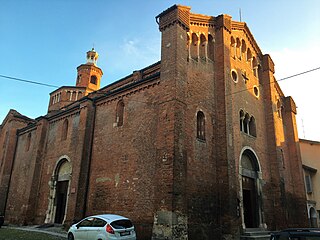
Santa Maria in Vallicella, also called Chiesa Nuova, is a church in Rome, Italy, which today faces onto the main thoroughfare of the Corso Vittorio Emanuele and the corner of Via della Chiesa Nuova. It is the principal church of the Oratorians, a religious congregation of secular priests, founded by St Philip Neri in 1561 at a time in the 16th century when the Counter Reformation saw the emergence of a number of new religious organisations such as the Society of Jesus (Jesuits), the Theatines and the Barnabites.

The Basilica of San Michele Maggiore is a church of Pavia, one of the most striking example of Lombard-Romanesque style. It dates from the 11th and 12th centuries.

Santa Maria del Carmine is a church in Pavia, Lombardy, northern Italy, considered amongst the best examples of Lombard Gothic architecture. It was begun in 1374 by Gian Galeazzo Visconti, Duke of Milan, on a project attributed to Bernardo da Venezia. The construction followed a slow pace, and was restarted in 1432, being finished in 1461.

Pavia Cathedral is a church in Pavia, Italy, the largest in the city and seat of the Diocese of Pavia. The construction was begun in the 15th century on the site of two pre-existing Romanesque, "twin" cathedrals. The cathedral houses the remains of St. Sirus, first Bishop of Pavia, and a thorn purported to be from the Crown of Thorns worn by Christ. The marble facing of the exterior was never completed.

Civita Castellana Cathedral is a cathedral in Civita Castellana, central Italy. It is the episcopal seat of the Diocese of Civita Castellana.

The Civic Museums of Pavia are a number of museums in Pavia, Lombardy, northern Italy. They are housed in the Castello Visconteo, or Visconti Castle, built in 1360 by Galeazzo II Visconti, soon after taking the city, a free city-state until then. The credited architect is Bartolino da Novara. The castle used to be the main residence of the Visconti family, while the political capital of the state was Milan. North of the castle a wide park was enclosed, also including the Certosa of Pavia, founded 1396 according to a vow of Gian Galeazzo Visconti, meant to be a sort of private chapel of the Visconti dynasty. The Battle of Pavia (1525), climax of the Italian Wars, took place inside the castle park.

The church and monastery of San Vittore al Corpo were an ancient monastery of the Olivetan order built in the early 16th century. The site was once a fourth century Roman imperial mausoleum of Maximian, that may also have held the burials of the emperors Gratian and Valentinian II, though they were more likely buried in another mausoleum, now the Chapel of Saint Aquilinus in the Basilica of Saint Lawrence. The basilica was enlarged in the 8th century to house the relics of the saints Vittore and Satiro. A Benedictine monastery soon was attached to the church. In 1507, the monastery was transferred to the Olivetans, who began a major reconstruction. Reconstruction of the church was begun in 1533 by Vincenzo Seregni, and completed in 1568 by Pellegrino Tibaldi. The façade remains incomplete. The dome was frescoed in 1617 by Guglielmo Caccia. In the chapel of St Anthony is a 1619 canvas by Daniele Crespi. In the transept on the left, is an early 17th-century cycle of canvases of the Stories of San Benedetto, by Ambrogio Figino while the right transept has three altarpieces by Camillo Procaccini. Other chapels have paintings by Pompeo Batoni and Giovanni Battista Discepoli.

San Teodoro is a Romanesque-style Roman Catholic church in the town center of Pavia, Italy.

Santi Primo e Feliciano is a Romanesque-style Roman Catholic church in the town center of Pavia, Italy.

Saint Lucius in Brugherio, Italy, is a small church dedicated to Saint Lucius in the grounds of the Villa Sormani. First located in Lugano, Switzerland, where it was a Franciscan chapel, the building was disassembled and transported to Brugherio, where its reconstruction was completed 17 years later.

Sant'Anna is a Catholic church in Alcamo, in the province of Trapani, Sicily, southern Italy.

San Lanfranco is a Romanesque-style Roman Catholic church and former abbey, located on via San Lanfranco Vescovo, 4/6, just west of the town center of Pavia, region of Lombardy, Italy.

Holy Family with Saint Catherine of Alexandria is a 1533 oil on canvas painting by Lorenzo Lotto, now in the Accademia Carrara in Bergamo. It is signed and dated "Laurentius Lotus 1533" and it measures 85.7 cm in height and 110.8 cm in width. Six later copies after the work are known. The Bergamo version is judged to be of exceptional quality, and the earliest.

The Basilika Palatina di Santa Barbara is the Palatine Chapel of the House of Gonzaga in Mantua, Italy.

The church of San Francesco of Assisi is a Catholic religious building in Pavia, Lombardy, Italy.

The church of Sant'Eusebio was a church of Pavia, of which today only the crypt remains. The church was probably built by the Lombard king Rothari (636-652) as the city's Arian cathedral. It later became the fulcrum of the conversion to Catholicism of the Lombards initiated by Theodolinda and the monks of San Colombano and which later received, precisely in Pavia, a great impulse from King Aripert I (653-661) and from Bishop Anastasius.

The church of San Giovanni Domnarum is one of the oldest in Pavia. In the crypt, which was rediscovered after centuries in 1914, remains of frescoes are visible.

The Basilica of Santissimo Salvatore is a church of Pavia. It was founded in 657 by the Lombard king Aripert I and became a mausoleum for many of the Lombard kings.

The church of Santa Maria in Betlem, founded around 1130, stands in the characteristic district of the Borgo of Pavia, located, after the Ponte Coperto, on the other bank of the Ticino river from the city center.

The church of San Marino is a Catholic church in Pavia, in Lombardy.























